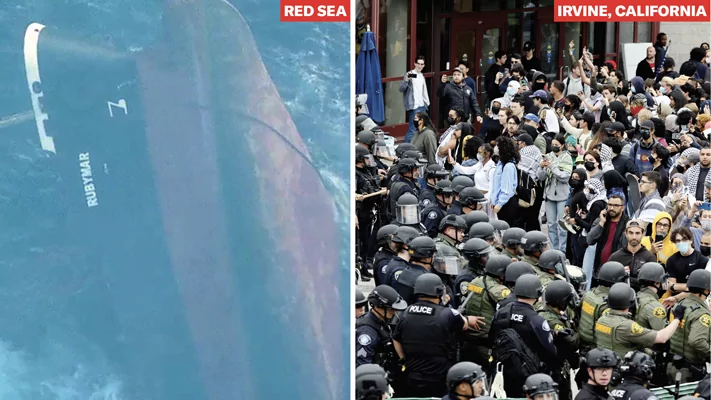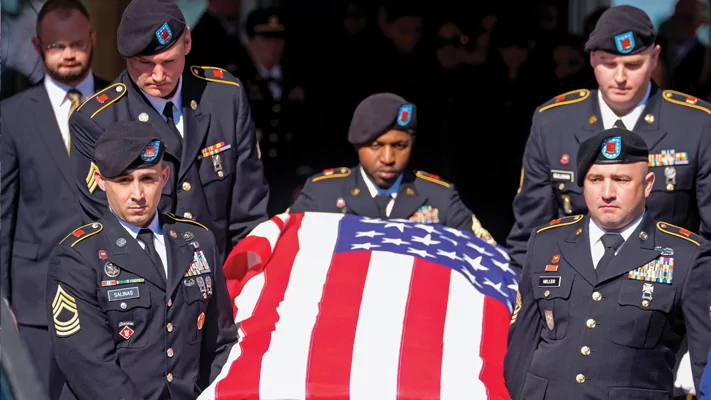
Earlier this month, Iran’s most well-known foreign proxy, Lebanon’s Hezbollah, launched numerous rockets at Israel, making international headlines. It is seen as part of Iran’s expected response to the assassination of Hamas leader Ismail Haniyeh on its own soil, which Iran blamed, or credited, depending on your point of view, on Israel. Yet Hezbollah launching rockets at Israel is not new. It’s been continuous starting almost immediately after Hamas’s assault on Oct. 7, 2023. Roughly 60,000 people were ordered to evacuate Israel’s northern border as a result. The latest attack only made major headlines because of Iran’s threatened retaliation.
This points to a larger truth: Much of what Iran and its vast network of influence operators, close allies, and proxy groups are doing across the region and even around the world escapes sufficient scrutiny by much of the public and even the policymaking community.

For example: How many know that Iran is busy propagandizing Shiite Muslims in Kashmir, a flash point between India and Pakistan? How many realize the true extent of Iran’s political influence in Europe or America, where it has fanned the flames of student protests, openly sought to “sell” Hamas’s murder of 1,200 Israelis to the public, and even carried out assassinations of Iranian Kurdish expats and others? Prior to the Houthi assault on Israel and on international shipping lanes in the Red Sea, including on American ships, how many understood the danger Yemen’s Houthi movement posed or the role of Iran in bringing it to prominence? And how many have a plan to counter any of this?
Secretary of State Antony Blinken had a call with Iraqi Prime Minister Mohammed Shia al Sudani. One of the topics raised, according to the State Department, was the “importance of Iraq’s responsibility to protect Coalition military advisors from attacks by Iran-aligned militias.” This is a vital issue that has gotten too little attention previously. That Blinken refers to the issue in such a short press release shows just how much Iranian influence has grown in importance to Washington.
It’s been a slow process, but concerns such as the vital issue of Iranian-backed militias in Iraq seem to be entering the consciousness of Washington. And the Biden administration, which has long been loath to take action against the Iran regime due mostly to an almost pathological desire to reenter something it could feasibly call a replacement for the so-called Iran deal, has slowly, and with far too little vigor, started pushing back against Iran’s toxic influence. Be it by calling out its support of student protests in America, shooting back at the Houthi assaults on the Red Sea, coordinating with regional allies, such as Israel and Bahrain, on efforts to deter Iran, or lifting the ban on weapons sales to Saudi Arabia, which has been at war with the Iran-backed Houthi movement in Yemen, there is a small but noticeable shift in the administration’s actions toward Iran’s provocations.

Iranian influence over Iraq, however, is perhaps the most dangerous of all these problems, relative to the attention it has gotten. Since the fateful decision by the U.S. to overthrow Saddam Hussein in 2003, most Americans who follow foreign policy debates are probably vaguely aware of Iranian influence in Iraq, particularly given the fact that Iraq is one of the only other majority Shiite Muslim countries in the world. But few understand just how toxic Iran’s influence is and how much that affects U.S. interests.
Last November, Sen. Tom Cotton (R-AR) led half a dozen senators in sending a letter to the Biden administration, saying, “In recent months, these Iraq-based terror groups reportedly murdered a U.S. citizen in Baghdad, murdered a U.S. contractor and wounded four U.S. service personnel in Syria, and abducted a U.S. based researcher. Many of these Iraq-based groups participated in the more than two-dozen attacks on U.S. troops in the region since October 17. In each such attack, groups responsible have ties to the IRGC, but are not currently designated as FTOs (Foreign Terrorist Organizations) under U.S. law.” The letter went on to name a handful of Iraqi militias that deserved U.S. designation as a terrorist organization, but were not currently designated, and requested action.
The examples of violence in Cotton’s letter, while horrifying, are outdated. Earlier this year, deputy Pentagon press secretary Sabrina Singh explained that “since Oct. 17, we’ve seen repeated attacks on U.S. forces, so we’re not discounting the fact that tensions are high, that these Iranian-backed groups are targeting our military members with the intention of trying to kill them.” She went on to list north of 160 attacks on U.S. troops by Iranian groups.

One example: This past April, multiple rockets struck a U.S. military base inside northeastern Syria on the Iraqi border. The group that claimed credit for that strike was Kataib Hezbollah, which despite sharing the name with Hezbollah, which translates to “Party of God,” in Lebanon is a distinctly Iraqi entity that nonetheless is also a proxy of Iran’s Islamic Revolutionary Guard Corps’s Quds Force. Formed in the mid-2000s and designated as a terrorist entity in 2009, Kataib Hezbollah was primarily responsible for an attack on a U.S. military base that killed a U.S. contractor and wounded several soldiers and an attack on the U.S. Embassy in Baghdad, both in 2020. It is also believed by the U.S. government to be the most likely source of the 2019 attack on the Saudi Arabian oil pipeline that upset world oil markets. The lack of a strong U.S. response startled Saudi Arabia and has complicated its relationships in the region.
It was these provocations and others that led then-President Donald Trump to issue the order to assassinate Gen. Qassem Soleimani, the leader of Iran’s Quds Force.
If there is still any doubt as to how Kataib Hezbollah thinks about the world, you can just check its Telegram channel. You don’t even have to be an Arabic speaker. A quick trip to Google Translate will tell you that its statements routinely refer to its “Zionist-American” enemies, justifications for killing U.S. troops whenever it finds them, and supposed U.S.-Israeli plots to murder innocent Muslims.
As Cotton’s letter alluded to, there are spinoff groups of Kataib Hezbollah. One group in Cotton’s letter, Usbat al Thaereen, translating to the League of Revolutionaries, is considered by researchers to be a project of Kataib Hezbollah. It claimed credit for the major March 11, 2020, attack on Camp Taji in Iraq, which hosts U.S. coalition forces near Baghdad.
As Caleb Weiss and Joe Truzman of the Foundation for Defense of Democracies put it, the “‘League of the Revolutionaries’ is likely a front group for other, more established Iranian proxies in Iraq … that allows for plausible deniability.” This attack was undertaken, according to a statement put out by the so-called League of Revolutionaries, in significant part for revenge against not only the killing of Soleimani but also of Abu Mahdi al Muhandis, who was killed along with him. Muhandis was the founder of Kataib Hezbollah.

Muhandis was more than a simple militia leader. Until he was taken out, he was a commander in the Iraqi Popular Mobilization Units, an Iraqi state-sponsored paramilitary network made up of over 60 different militias, including Kataib Hezbollah. According to the Washington Institute for Near East Policy, “The genesis of the PMU forces as a concept dates back to [senior Iraqi Shiite cleric] Ayatollah Ali al-Sistani’s fatwa on June 13, 2014,” in response to the ISIS crisis. After the 2011 pullout of U.S. troops from Iraq, according to California State University professor Ibrahim al Marashi, America and the broader anti-ISIS coalition were forced into an “uneasy relationship” with these organizations to ensure ISIS was defeated. Warnings from people such as Gen. David Petraeus, who argued that the U.S. risked taking sides in a Sunni-Shiite war, and implicitly on the side of Iran, were overruled.
While the PMUs were intended to be temporary, and in spite of the fact that Sistani has denounced the PMUs’ abuse of his fatwa and asked Iraqis to join the regular Iraqi military, they nonetheless became a permanent part of the Iraqi political structure. Nadine Maenza, a former chairwoman of the U.S. Commission on International Religious Freedom, explained that “the word ‘militia’ can be misleading as this is not the kind of volunteer groups found in the United States. These militias … have their salaries paid by the Iraqi government, but most take their orders from religious leaders in Tehran.” Accepted as a branch of the Iraqi military in 2016, PMUs have become a permanent part of the Iraqi governmental structure.
Last June, the Iraqi parliament voted to support PMUs to the tune of $600 million. But these funds are only part of the large financial network that supports many of these organizations. Jonathan Spyer, an Israel-based expert who interviewed Muhandis in Iraq in 2015, explained that the largest such militias “control real estate, businesses, land, weaponry, and prisons of their own.” Indeed, their corrupt activity gives PMUs leverage over big money industries, including oil, scrap metal, and construction. Some PMUs run “checkpoints,” which can earn more than $100,000 a day.
It gets more complicated quickly. Sudani’s “National Unity” government relies on support from various factions, including ones that are openly political arms of various PMUs. According to Iraq expert Hussain Abdul-Hussain, Sudani’s Cabinet “is a mixed bag that has anti-Iran ministers and pro-Tehran ones,” citing one who actually helped storm the headquarters of Kataib Hezbollah in 2015 as an Iraqi military officer and another who is a former PMU spokesman and a commander in the Jund al Imam militia, an Iranian-backed militia dating back to the 1991 uprising against Saddam that reemerged during the fight against ISIS.
This coalition creates problems in Washington. This past March, Cotton and a handful of other Republicans in Congress called on the Biden administration to cancel a meeting with Sudani due to the Iraqi government’s relationship with these PMUs, as well as Baghdad’s difficult relationship with the Kurdish Regional Government in northern Iraq.
If all of this seems bewildering, that’s an intentional effect of what Iran is trying to do. True, some of these groups have different goals in Iraq, and not all of them are supporters of Iran per se. A small number of them are supporters of Iraqi cleric Muqtada al Sadr, who has a complicated, but not always adversarial, relationship with Iran. But as Cotton’s November letter suggested, there are numerous splinter groups, umbrella groups, and other PMUs and their offshoots, most of which are backed by Iran, that are constantly popping up. While they may have different goals in Iraq — they even fight at times — they share a loyalty to the Iranian theocracy and a hostility toward the U.S. and its allies. And they are increasingly woven into the fabric of Iraqi politics in a way that becomes very hard to disentangle.
Washington’s posture toward Iran can’t untie this Gordian knot. But an effective strategy can at least start with acknowledging the problem. On that, there is some movement.
Cotton’s November letter got noticed inside the Senate. The most recent Senate version of this year’s National Defense Authorization Act includes an extensive provision that requires the Biden administration to provide “a determination of whether other militant organizations have splintered from, or developed as offshoots of, the Badr Organization, Asa’ib Ahl al Haq, Kata’ib Hezbollah, or any other organization designated as a foreign terrorist organization” and requires specific “description of the Badr Organization, the People of the Cave, al-Mohandes’s Revenge Brigade, the League of Revolutionaries, the Inheritors, and the Bridge of Victors and their involvement in attacks on United States forces, allied forces, and other related entities in Iraq,” as well as human rights violations by these same groups. The language also forbids U.S. funds from going to any of these groups.
Looking at some of these groups provides insights into how these militias operate. The Badr Organization, for example, is perhaps the most powerful of all Iraqi PMUs and, according to one scholar, has a “history as a veritable Iraqi unit of the IRGC,” which created it during the Iran-Iraq war of the 1980s and simply marched back into Bagdad after the fall of Saddam. Some of its members carried equipment into Iraq labeled “Property of the Islamic Revolutionary Guard Corps.” During this period, it is accused of attacks on thousands of Iraqi Sunni Muslims. Badr also acted as a key incubator for more recent and even more radical militias, including Kataib Hezbollah.
And yet, despite the fact that it is simply an Iraqi unit of the IRGC, a designated group, and has founded other designated groups, Badr itself is technically not designated. Rep. Joe Wilson (R-SC) proposed a bill to designate Badr in 2020, but it went nowhere. In the meantime, Badr remains influential in Iraqi politics, holding seats in the parliament, and it has even had a minister.
The Inheritors is the mirror image of Badr, the new kid on the block. Founded in 2019 by the IRGC’s Quds Force, it immediately began attacking U.S. military assets in Iraq. It has repeatedly made it clear that it wants revenge for the killing of Soleimani and Muhandis, and it is run by a former top aide to Soleimani known as Hajj Hamid. The Inheritors took responsibility for a 2022 drone attack on U.S. military facilities at Kuwait’s Ali al Salem Air Base.
The People of the Cave, an allusion to a popular Muslim parable, seems to be a new facade group, founded in 2019, whose allegiances are murky. But it is clearly aligned with several other deadly Iran-backed militias. In July of 2023, it laid siege to the U.S. Embassy in Baghdad.
The Islamic Resistance in Iraq, an “umbrella term used to describe operations by all Iran-backed Iraqi militias conducted in solidarity with the 2023-24 war between Hamas and Israel,” according to the Washington Institute, claimed responsibility for the drone attack on U.S. troops in Jordan, which killed three soldiers.
Other sins and other groups would be easy to name. But you’re getting the picture. Prominent Iranian expats, such as Vahid Beheshti, are fond of calling the Iranian clerical regime an “octopus” for its many tentacles around the region, and indeed the world, but nowhere is this more clear than in Iraq.
The IRGC is easily circumventing U.S. sanctions and avoiding significant accountability by opening up new groups and using thin pretexts to pretend they’re different. Meanwhile, these organizations are increasingly woven into the fabric of Iraq’s parliament, media, and politics. This benefits Iran immensely, but it hurts America, Iraq, and America’s other friends in the region.
About a year and a half ago, I asked a federal official involved in Middle Eastern affairs what “the building,” a colloquialism for the State Department, thought about various goings on in Iraq, having in mind it may be as concerned as I am about Iranian influence. The response amounted to: “It’s not in the headlines, so the building is not thinking about it much at all.” It was a refreshingly frank, and terrifying, explanation about how American foreign affairs is too often conducted.
CLICK HERE TO READ MORE FROM THE WASHINGTON EXAMINER
Yet the attention on these issues has grown since then. Blinken’s statement, Congress’s actions, and increased media attention show that. It’s worth mentioning that while it was undoubtedly Cotton’s influence that ensured that the ideas contained in his letter were translated to the NDAA provision, Republican support alone was insufficient. It required, at minimum, the acquiescence of Senate Armed Services Committee Chairman Jack Reed (D-RI) and other committee Democrats.
Washington is nowhere close to coming up with a coherent policy to neutralize the Iranian threat in Iraq or anywhere else and is even further from a policy that could gain bipartisan support. But Washington is taking this problem more seriously than it has in the past. Neither America nor Israel nor their Arab allies will ever neutralize the Iranian threat by cutting off Iran’s various tentacles. They will benefit greatly, however, from declining to play along with the pretext that every time a new group in Iraq pops up and strikes the U.S. or its allies, it is an independent event or we don’t know that Tehran is ultimately responsible.
Clifford Smith is a former congressional staffer and an attorney.





